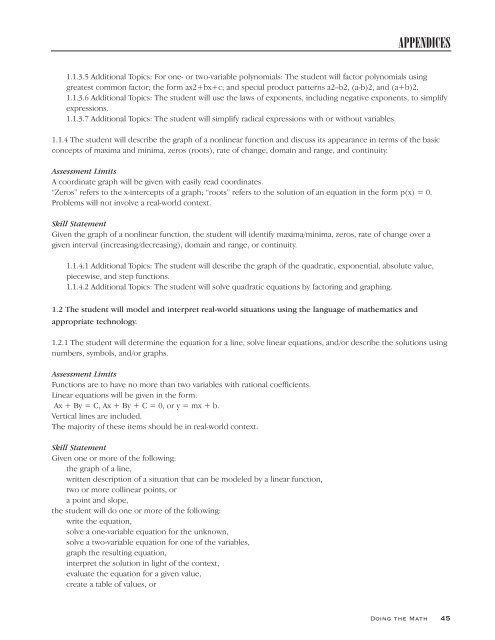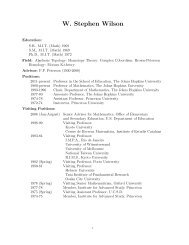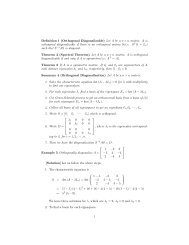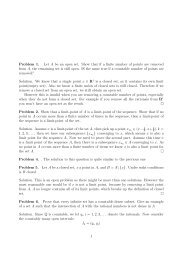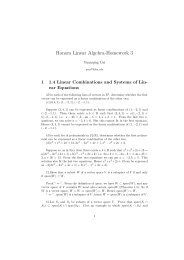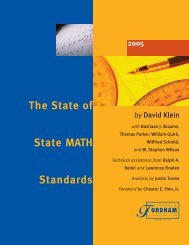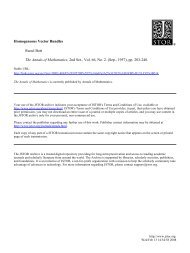Doing the Math - JHU Mathematics - Johns Hopkins University
Doing the Math - JHU Mathematics - Johns Hopkins University
Doing the Math - JHU Mathematics - Johns Hopkins University
Create successful ePaper yourself
Turn your PDF publications into a flip-book with our unique Google optimized e-Paper software.
APPENDICES<br />
1.1.3.5 Additional Topics: For one- or two-variable polynomials: The student will factor polynomials using<br />
greatest common factor; <strong>the</strong> form ax2+bx+c; and special product patterns a2–b2, (a-b)2, and (a+b)2.<br />
1.1.3.6 Additional Topics: The student will use <strong>the</strong> laws of exponents, including negative exponents, to simplify<br />
expressions.<br />
1.1.3.7 Additional Topics: The student will simplify radical expressions with or without variables.<br />
1.1.4 The student will describe <strong>the</strong> graph of a nonlinear function and discuss its appearance in terms of <strong>the</strong> basic<br />
concepts of maxima and minima, zeros (roots), rate of change, domain and range, and continuity.<br />
Assessment Limits<br />
A coordinate graph will be given with easily read coordinates.<br />
“Zeros” refers to <strong>the</strong> x-intercepts of a graph; “roots” refers to <strong>the</strong> solution of an equation in <strong>the</strong> form p(x) = 0.<br />
Problems will not involve a real-world context.<br />
Skill Statement<br />
Given <strong>the</strong> graph of a nonlinear function, <strong>the</strong> student will identify maxima/minima, zeros, rate of change over a<br />
given interval (increasing/decreasing), domain and range, or continuity.<br />
1.1.4.1 Additional Topics: The student will describe <strong>the</strong> graph of <strong>the</strong> quadratic, exponential, absolute value,<br />
piecewise, and step functions.<br />
1.1.4.2 Additional Topics: The student will solve quadratic equations by factoring and graphing.<br />
1.2 The student will model and interpret real-world situations using <strong>the</strong> language of ma<strong>the</strong>matics and<br />
appropriate technology.<br />
1.2.1 The student will determine <strong>the</strong> equation for a line, solve linear equations, and/or describe <strong>the</strong> solutions using<br />
numbers, symbols, and/or graphs.<br />
Assessment Limits<br />
Functions are to have no more than two variables with rational coefficients.<br />
Linear equations will be given in <strong>the</strong> form:<br />
Ax + By = C, Ax + By + C = 0, or y = mx + b.<br />
Vertical lines are included.<br />
The majority of <strong>the</strong>se items should be in real-world context.<br />
Skill Statement<br />
Given one or more of <strong>the</strong> following:<br />
<strong>the</strong> graph of a line,<br />
written description of a situation that can be modeled by a linear function,<br />
two or more collinear points, or<br />
a point and slope,<br />
<strong>the</strong> student will do one or more of <strong>the</strong> following:<br />
write <strong>the</strong> equation,<br />
solve a one-variable equation for <strong>the</strong> unknown,<br />
solve a two-variable equation for one of <strong>the</strong> variables,<br />
graph <strong>the</strong> resulting equation,<br />
interpret <strong>the</strong> solution in light of <strong>the</strong> context,<br />
evaluate <strong>the</strong> equation for a given value,<br />
create a table of values, or<br />
<strong>Doing</strong> <strong>the</strong> <strong>Math</strong> 45


